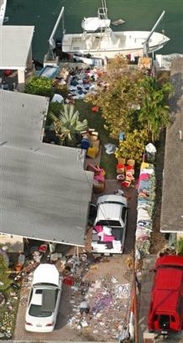|
Florida begins to recover from Hurricane
(AP)
Updated: 2005-10-26 20:14
Electricity was restored to the luckiest homes and
businesses. A few gas stations and eateries opened, more streets became passable
and even trash removal returned to some overwhelmed areas.

In this photo provided by the Florida Keys
News Bureau, a family's personal belongs dry out Tuesday, Oct. 25, 2005,
in Key west, Fla., a day after Hurricane Wilma passed over South Florida.
[AP] |
Still, despite all the small causes for celebration across Florida in the
immediate aftermath of Hurricane Wilma, much of the focus remained on the
immense problems that could plague the state for weeks during its recovery
efforts from the Category 3 storm.
The 21st storm in the worst Atlantic hurricane season on record, Wilma was
blamed for at least five deaths in Florida alone. Before hitting the United
States, it killed at least four people in Mexico, one in Jamaica and 12 in Haiti
as it swirled across the Caribbean.
Trucks carrying the first wave of relief in Florida — food, ice and water —
either arrived much later than local officials expected, or simply didn't show
up at all. Hundreds of people lined up outside one home-supply store, desperate
for cleanup and other items. Drivers waited five hours at gas stations, and at a
handful of fast-food restaurants open in the Miami area, burgers were available
— to those willing to endure two-hour waits.
Nine hours after she first got on line at one of the designated relief-supply
locations, Fanie Aristil, 23, of North Miami wearily left for home with 28
pounds of ice and six liters of bottled water.
"All that time," Aristil said. "This is all we get?"
FEMA spokeswoman Frances Marine urged Floridians to be patient, and reminded
residents that problems such as the ones that popped up Tuesday were why
officials suggested that people have 72 hours of essential supplies — including
water — available ahead of Wilma's arrival.
"People will have their needs met," Marine said. "The bottom line is that
there's a plan in place."
Gov. Jeb Bush predicted that his "battle-tested" state would steadily see
better days, and his older brother, President Bush, planned a Thursday visit to
assess damage in Florida.
The quantity of debris was daunting: Pieces of roofs, trees, signs, awnings,
fences, billboards and pool screens were scattered across several counties.
Damage estimates ranged up to $10 billion, and the landscape of the state's most
populous region — the Miami, Fort Lauderdale and West Palm Beach area — was
laden with destruction.
Some of the worst damage was in downtown Fort Lauderdale, where Wilma was the
strongest hurricane to strike since 1950. Winds of more than 100 mph blew out
windows in high-rises, many built before Florida enacted tougher construction
codes following Hurricane Andrew in 1992.
Wilma knocked out power for hundreds of miles, cutting off electricity to a
staggering one out of three Florida residents. Florida Power & Light, the
state' biggest utility, said Wilma affected more of its 4.3 million customers
than any other natural disaster in the company's history.
By early Wednesday, 13 percent of FPL's customers who lost service because of
Wilma had their lights back on — but the company continued to remind Floridians
that a total restoration may take weeks.
At Miami International, the busiest U.S. hub for Latin American travel, the
first plane to land since the hurricane arrived Tuesday from Brazil, and
domestic flights were to resume Wednesday morning. Airports at Fort Lauderdale
and West Palm Beach remained closed to commercial traffic but emergency aircraft
were coming into both facilities.
"It's not a vacation anymore," said Gary Coombe, who brought his wife and two
children to Florida from Geneva, Switzerland. "It's a frustration."
In Mexico, thousands of haggard tourists battled for airline and bus seats
out of the country's hurricane-battered Caribbean resorts on Tuesday after five
days in hot and dirty emergency shelters.
President Vicente Fox's office said that about 22,000 foreign tourists
remained in the area, down from a peak of almost 40,000.
|